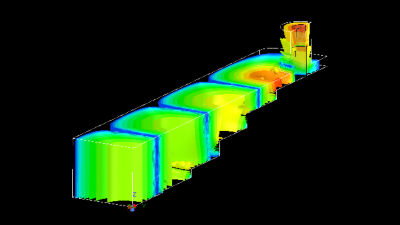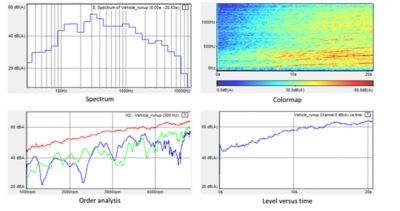ANSYS BLOG
March 14, 2022
DC to Daylight: The Foundation of Computational Electromagnetics
How does all this stuff work? Ansys computational electromagnetics (CEM) experts answer that question in a new webinar series.
Ansys HFSShas a 30-year legacy in the application of CEM for solving the most challenging problems in electromagnetics and electronics design. A uniquely sophisticated technology, HFSS has evolved to incorporate multiple numerical methods, such as the finite element method (FEM), method of moments (MoM), discontinuous galerkin method (DGTD), physical optics (PO), and the shooting and bouncing rays (SBR) method. This breadth of techniques enables users to simulate electromagnetic phenomena on a scale ranging fromnanoscale on-chip microelectronics to macro-scale systems such as servers, automobiles, aircraft, and even ships. The accuracy and solution reliability of this technology has been critical to the development of a vast swath of technologies and products through the years and around the globe.

Figure 1. Coax to waveguide transition with symmetry plane was the first geometry simulated by HFSS.
My own initial experience with HFSS was doing antenna design, where I was stunned by its accuracy — an accuracy resulting in a single purple line when comparing far field plots, withmeasurements in red and HFSS in blue. And I suspect that, like many other users, a question that came to mind for me was,“How does all of this stuff work?”
Since joining the HFSS team in 2001, I have had the great fortune of working with some brilliant engineers and software developers. They have taught me much about this technology’s fundamentals and foundations, which has enhanced my personal use of the technology. I suspect any user would be similarly interested in gaining such insight.
So, to provide a deeper insight to CEM, Ansys will host a five-part webinar series on theFoundation of Computational Electromagnetics. This webinar series will provide attendees a unique opportunity to hear from Ansys CEM experts and answer the question: “How does this stuff work?”
Here’s a sneak peek:
Foundation of Computational Electromagnetics - March 22
This presentation, led by Dr. Eric Bracken, Ansys Fellow and chief technologist, will paint a broad picture around the many solver techniques available in CEM, from quasi-static electric and magnetic fields through radiofrequency (RF) and microwave to visible light, at scales ranging from individual transistors to many city blocks. It will be an overview of the different approaches used in these solvers and discuss some of the trade-offs that are made in choosing a particular solution method for a given application. Attendees will gain a better appreciation of the breadth and depth of available technologies and techniques in CEM.
An Overview of the Foundation of HFSS and Maxwell Solver Technologies-March 30
Drs. Rickard Petersson and Ping Zhao, research and development directors, will discuss the methodologies in HFSS andAnsys Maxwell. These are the premier electromagnetic simulation tools used globally by engineers for decades to design electronic devices and products such as antennas, PCBs, connectors, electric motors, transformers, and more. They will cover the foundational technologies for HFSS and Maxwell in addition to more recent advanced features. Numerical methods (finite elements, integral equations, etc.) will be discussed along with solver options such as direct and iterative algebraic solvers. In addition, high-performance computing (HPC) options used to solve larger problems and reduce simulation time will be reviewed. The advanced physics techniques in Maxwell, such as vector hysteresis, irreversible temperature effects on demagnetization, magnetostriction modeling, and Litz wire modeling, will be highlighted. Finally, an integrated workflow example for multiphysics, thermal management, and noise, vibration, and harshness (NVH) will be demonstrated.

Figure 2. Simulations of electric motor in Maxwell (left); EMI/EMC test chamber in HFSS (right).
The Foundation of Domain Decomposition Technologies in HFSS - April 12
Dr. Kezhong Zhao will present on the significant advanced solver techniques deployed in HFSS over the last decade. Some of these new technologies, such as the general domain decomposition solver, hybrid finite element-boundary integral solver (FE-BI), hybrid integral equation region solver (IE region), and the more recent 3D component array and mesh fusion solvers, are all based on the powerful domain decomposition method (DDM). DDM is a technique that enables HFSS to exploit HPC capabilities to solve electromagnetic problems of unprecedented size and scope. DDM decomposes the original problem into subdomains, with the continuity of EM fields at the interfaces enforced through a suitable boundary condition. Among the many benefits of DDM is that the most efficient solver or meshing technology can be employed in each domain, a benefit exploited to considerable benefit in the recent introduction of HFSS mesh fusion technology.
Foundation of Ray Tracing Methods in Electromagnetics - April 21
Dr. Robert (Bob) Kipp will discuss simulations at extreme scale. A wide class of electromagnetic problems involve objects and environments that span hundreds to many thousands of wavelengths: installed antenna performance and coupling, indoor/outdoor RF propagation, inter-vehicle (V2V and V2X) communication, radar signatures and sensing, and reflector and lens antennas. Whether for rapid turnaround or just to fit a simulation into available computing resources, large-scale problems remain the sweet spot of high-frequency asymptotic methods. In this webinar, Bob will present the latest techniques and capabilities of the SBR method. The discussion will start with traditional SBR and then show its extensions to incorporate edge diffraction mechanisms, fuselage-hugging creeping waves, and refraction in dielectric volumes. Then SBR will be related to other full-wave and ray-tracing methods to demonstrate how there are massive parallelization potentials with graphics processing units (GPUs). Practical examples from diverse application areas will be presented to illustrate the accuracy, speed, and overall practicality of SBR, showing its value in the CEM toolbox.
The Foundation of Computational Optics and Photonics - April 28
Dr. James Pond, principal product manager and former chief technology officer of Lumerical,will present on optics, photonics, and light. The simulation of optical and photonic devices requires a wide range of solvers to cover multiple length scales and physical effects. Simulations can model nano-scale devices, such as image sensor pixels, multi-quantum well lasers, and micro-LED emitters, as well as macroscale systems, such as augmented reality displays and full automobile scenes with multiple light sources and camera sensors. Furthermore, system modeling involves combining simulations from multiple scales. For example, the analysis of a smart phone display requires the simulation of individual pixels, as well as the simulation of an entire scene with different sources of ambient light to perform human vision analysis. James will review various methods of simulating electromagnetics for optics, from ray tracers to full wave electromagnetic solvers, as well as specialty solvers for periodic and planar systems. In addition, James will discuss the simulation of quantum and electro-optical effects for light absorption, emission, modulation, and amplification and will conclude with a discussion on solvers for integrated photonic circuits for both classical and quantum applications. The audience will gain an understanding of the multiphysics, multiscale nature of optics and photonics, the simulation challenges this creates, and the breadth of solvers available to overcome.
We hope you will be able tojoin us in this webinar seriesas we examine the breadth and depth of Ansys CEM technology, from DC to daylight. If you are interested in CEM and how it works, don’t miss out.













